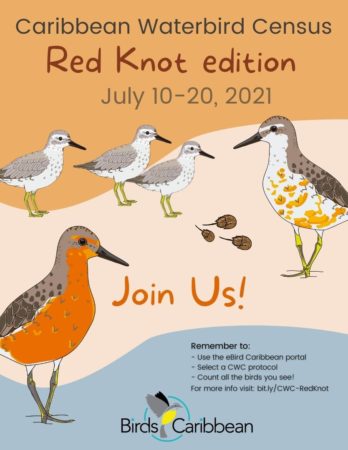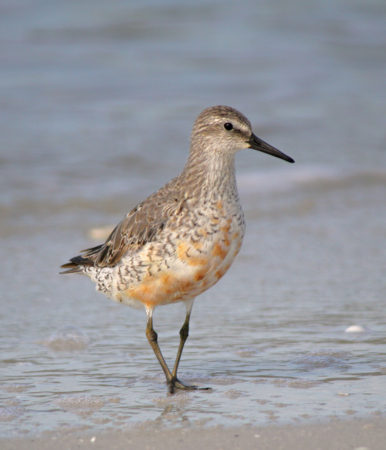 Red Knots are known for their extraordinary long-distance migrations. On the Atlantic Flyway they head north from their main wintering areas in South America to breed in the Arctic, traveling as far as 15,000 km each way! Here in the Caribbean, they winter in small numbers on various islands, and we see them also during Fall and Spring migration. Counts of birds on northward migration are way down from previous years, causing great concern. Did something different happen this year? Where are the missing Red Knots? We need your help to find out!
Red Knots are known for their extraordinary long-distance migrations. On the Atlantic Flyway they head north from their main wintering areas in South America to breed in the Arctic, traveling as far as 15,000 km each way! Here in the Caribbean, they winter in small numbers on various islands, and we see them also during Fall and Spring migration. Counts of birds on northward migration are way down from previous years, causing great concern. Did something different happen this year? Where are the missing Red Knots? We need your help to find out!
Target count dates are July 10-20, but counts at any time during July are welcome!
When Red Knots migrate north to their breeding grounds they will stop along the way to refuel, gathering in large flocks at key sites to rest and feed. These sites are vital for Red Knots and other shorebirds to re-build fat reserves before completing their long journeys north to breed. Counting birds at these sites can give us an indication of how the populations of these birds are faring.
You may have heard that this year, on spring migration, a very steep decline in Red Knot numbers was recorded at one such site. The count of Red Knots at Delaware Bay (New Jersey, and Delaware) where knots gather in huge numbers to gorge on the eggs of spawning Horseshoe Crabs, was just 6,800. This is an alarmingly low count compared to the 19,000 seen last year, and 30,000 seen in 2018 and 2019. In fact, this year’s count was the lowest recorded since the 1980s when the population was about 90,000.
Help Us Find Out What Happened: CWC count July 10-20
We are asking for your help in July to try to understand what happened. It is possible that some of the ‘missing’ Red Knots decided not to migrate north and spent the breeding season in their wintering areas or stopped their journeys before reaching this key stopover site. As part of an international coordinated effort, we would like you to carry out a Caribbean Waterbird Census (CWC) count at wetlands and beaches you know are good for shorebirds, from July 10 – 20. These are the key dates for the coordinated count, but if you cannot make it out during this period doing a CWC count at any time in July will also help.
Red Knots in Trouble

We already know that Red Knots are in trouble, like many other shorebirds. They are threatened by climate change, loss of habitat, reduction in food resources, human disturbance, and hunting. The birds using Delaware Bay as a stopover site are of the Rufa sub-species of Red Knots, listed as Threatened since 2014. This sub-species also migrates through the Caribbean on the Atlantic Flyway and winters in small numbers in the islands. The population of rufa Red Knots is estimated to have declined by 75% in recent years and the USFWS say threats to this sub-species put it “in danger of extinction in the next few decades.” So, it is vital that we try to understand what has happened to Red Knots this year!
Ornithologists report that although horseshoe crab eggs were abundant at Delaware Bay, numbers of some of the other migratory shorebirds that stop there, like Ruddy Turnstones, Semipalmated Sandpipers, and Sanderlings were also lower than expected this year. One factor that may have contributed to low numbers of knots was poor reproduction on the breeding grounds last year (there is some evidence for this). Or perhaps migration was delayed due to poor weather, or there was abundant food at another stopover site and so not as many birds used Delaware Bay.
It’s also possible that more birds than usual may have stayed in the Caribbean or other parts of their nonbreeding range instead of migrating north—some juvenile Red Knots do not reproduce in their first year and spend the breeding season in different places across the Americas. Or perhaps some unknown factor (e.g., disease, a storm, etc.), caused the demise of a large numbers of birds. We hope that this is not the case!
Red Knot ID Tips – Click on each photo below to view larger.
Your CWC Count Data is needed!
We need our CWC monitors throughout the Caribbean to help this international effort to try and understand why numbers of Red Knots and other shorebirds are down this year. Please carry out as many counts as you can during the period July 10-20. When you do your CWC count, remember to keep an eye out for other shorebird species at the same time, and that you should count all the birds you see (of any species, including “landbirds”) on each count—doing a complete count greatly increases the value of your data to science and conservation.
Don’t forget to enter your data in eBird Caribbean using one of the CWC protocols on Step 2 of data entry. If using eBird mobile, set your portal to eBird Caribbean to access the CWC options for your checklists/ counts at wetlands and beaches). Thanks to you, we now have 11+ years of CWC data and counting, and are able to look at status and trends for many species at different sites and in the region overall. Remember that CWC counts can be done at any time of year—whenever you are conducting a count at a wetland, mangrove, salt pond, or beach, make it a CWC count.
You can find out more about CWC monitoring on our CWC page and find Shorebird Resources on our website and Youtube channel – we have lots of great resources to help you with your wetland and shorebird bird ID! Are you familiar with the Red Knot? You can find out more about them in our World Migratory Bird Blog Post or learn more about them, including photos, and calls on eBird.
Share this special CWC July Count, Red Knot edition, with your networks!
As mentioned above this is an international collaborative effort, thus, we would like people to carry out counts throughout the Caribbean and the Americas! We have prepared promotional graphics (portrait, landscape, square) in English, Spanish, and French for our partners in the Caribbean – you can download them here. If you would like to use and adapt these graphics for your country, you are welcome to do so! Contact Lisa.Sorenson@BirdsCaribbean.org.
Please, do remember to follow any COVID rules and precautions in your country when doing surveys.
Thank you for contributing to our knowledge base, as we try to solve the mystery of the missing Red Knots.












